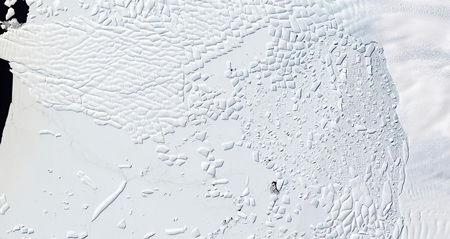Washington (AP) – Warmer air, less frigid water and gravity may combine to make parts of Antarctica’s western ice sheet melt far faster than scientists had thought, raising sea levels much more than expected by the end of the century, according to a new study.
New physics-based computer simulations forecast dramatic increases in melting in the vulnerable western edge of the continent. In a worst-case scenario, that could raise sea levels in 2100 by 18 to 34 inches (46 to 86 centimeters) more than an international panel of climate scientists predicted just three years ago.
 This satellite image provided by Nature/Knut Christianson, taken Jan. 9, 2016, shows the Thwaites Glacier and its ice cliff at the terminus of Thwaites Glacier, West Antarctica. A new study says ice cliffs may lead to faster melting of Antarctic ice sheets and more sea level rise than previously thought with the Thwaites Glacier and its ice cliffs as the most likely place for this process to start. (Knut Christianson/Nature via AP)
This satellite image provided by Nature/Knut Christianson, taken Jan. 9, 2016, shows the Thwaites Glacier and its ice cliff at the terminus of Thwaites Glacier, West Antarctica. A new study says ice cliffs may lead to faster melting of Antarctic ice sheets and more sea level rise than previously thought with the Thwaites Glacier and its ice cliffs as the most likely place for this process to start. (Knut Christianson/Nature via AP)
And even if countries control heat-trapping gases at the moderate levels they pledged in Paris last year, it would still mean seas three to 12 inches (8 to 31 centimeters) higher than have been forecast, according to a study published last month in the journal Nature.
By the year 2500, in the worst-case scenario, the simulations predict seas 42 feet (13 meters) higher – purely from Antarctic melt.
“You’re remapping the way the planet looks from space with those numbers, not just subtle changes about which neighborhoods are going to be susceptible to storm surge,” said study lead author Robert DeConto, a climate scientist at the University of Massachusetts.
This is all because Antarctica is one of the biggest wild cards when scientists try to assess the effects of man-made climate change in upcoming decades. Scientists were caught by surprise when the western portion of the continent started showing signs of rapid ice loss in the last decade or so.
The United Nations’ Intergovernmental Panel on Climate Change has not forecast much sea level rise from Antarctica, just seven inches (18 centimeters) by 2100 in their last report. For this century, the panel saw water expanding from heat, glacier melt and Greenland ice sheet loss as bigger factors.
Instead of seven inches, DeConto’s simulations forecast sea level rise from Antarctica’s melt alone as 2 to 3 feet (64 to 105 centimeters) in the worst-case scenario and 10 to 19 inches (26 to 49 centimeters) if greenhouse gas emissions are moderately controlled. If the world cracks down more dramatically on heat-trapping gases, Antarctica would essentially not add anything to sea level rise, the study said.
But those figures are just worldwide averages. In many places on the U.S. East Coast, like Boston, it could be 25 percent more than that because of geological conditions, DeConto said.
“North America has a lot to fear from ice loss from West Antarctica, which is where it all begins,” DeConto said.
While other studies have looked at the effect of warming from water below ice sheets and the air that melts from above, DeConto adds in the effect of pooling water and giant ice cliffs. Those ice cliffs, which can be dozens and even hundreds of feet high, can collapse from the sheer weight of ice and that hastens glacier and ice sheet retreat, he said.
Ted Scambos at the University of Colorado, who wasn’t part of the new study, said it was plausible and used “a few simple yet under-appreciated factors regarding ice retreat.”
Carnegie Institute climate scientist Chris Field said the study drives home the difference the world can make by controlling its greenhouse gas emissions. It’s the difference between rising seas that can be managed and conditions that are “dangerously risky,” he said.
Online:
Nature: http://www.nature.com/nature




